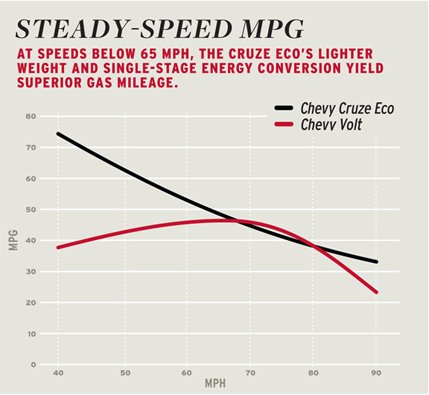 Comparison Tests
Comparison Tests

Like some pro party animal tripping across the 40-year threshold into middle age, today’s car world is fraught with 40-mpg angst. Even Ferraris and F-150s are heading toward the big Four-Oh by gummint decree. The good news: We get to curb Middle Eastern oil-freighter traffic while enjoying new strides in efficiency. Major mpg has escaped the lab and infiltrated our new-car fleet, and everybody feels like a winner.
Consider the Chevrolet Volt and Cruze Eco butting heads here. The EPA has awarded both cars exemplary highway-mileage pins: 42 mpg for the Cruze, 40 mpg for a Volt running on premium gas. While the two share GM’s global compact-vehicle platform, each represents a different path to the future. The Cruze is a ’55 Chevy updated for the 21st century; it’s an affordable four-door sedan with a tiny turbo engine, tall gearing, and various efficiency improvements. Chevy’s groundbreaking Volt is the pluperfect Toyota Prius—an electric car with backup gas power to avoid range anxiety; in other words, the most advanced hybrid money can buy.
Most new-car watchers already know that the Volt can post spectacularly elevated mpg figures if used only for short commutes. But how does the Volt fare in the real world, i.e., one in which there are emergencies, airport runs, and birthday parties in B.F.E.? Does it beat the workaday Cruze when taken out of its carefully circumscribed environment? Can the Volt provide the kind of driver enjoyment we’re growing accustomed to in the new crop of compact sedans? And, lest we forget, what about value?
To find out which Chevy is the all-around shrewder solution, we hit the test track and logged 1000 miles on both Michigan peninsulas, local city streets, and a suburban-commute route. But this is no hypermiling exercise. We cruised just above the posted speed limit, drafted no semis, and enjoyed the comforts of each car’s climate-control system. The fact that we easily scored 40-plus mpg in both Chevys proves that the high-efficiency era is off to a painless start.


 In EPA city and highway MPGe calculations, each 33.7 kWh of electricity consumed equals one gallon of gas.
In EPA city and highway MPGe calculations, each 33.7 kWh of electricity consumed equals one gallon of gas. The energy used to produce the fuel (the so-called well-to-tank content) is not included.
The energy used to produce the fuel (the so-called well-to-tank content) is not included. No mixed-mode testing: The EPA runs Volt city and highway tests twice—once on battery power, then a second time with the engine running. The combined figure is the usual blend of 55 percent city and 45 percent highway.
No mixed-mode testing: The EPA runs Volt city and highway tests twice—once on battery power, then a second time with the engine running. The combined figure is the usual blend of 55 percent city and 45 percent highway. Corporate Average Fuel Economy calculations use a different conversion system devised by the Department of Energy that does include well-to-tank energy consumption. The DOE’s petroleum equivalency factor (PEF) is 82.049 kWh per gallon for cars with no petroleum-powered accessories and 10 percent less for cars that do use gas or diesel fuel to power accessories. The PEF starts with the same gas-to-electricity conversion used by the EPA in its tank-to-wheels calculations (33.705 kWh/gal), then adds corrections for electric-generation efficiency (0.328), power-transmission efficiency (0.924), petroleum refining and distribution efficiency (0.83), plus a 0.15 factor “included to reward electric vehicles’ benefits to the nation relative to petroleum-fueled vehicles.” For math hounds, the actual equation is:
Corporate Average Fuel Economy calculations use a different conversion system devised by the Department of Energy that does include well-to-tank energy consumption. The DOE’s petroleum equivalency factor (PEF) is 82.049 kWh per gallon for cars with no petroleum-powered accessories and 10 percent less for cars that do use gas or diesel fuel to power accessories. The PEF starts with the same gas-to-electricity conversion used by the EPA in its tank-to-wheels calculations (33.705 kWh/gal), then adds corrections for electric-generation efficiency (0.328), power-transmission efficiency (0.924), petroleum refining and distribution efficiency (0.83), plus a 0.15 factor “included to reward electric vehicles’ benefits to the nation relative to petroleum-fueled vehicles.” For math hounds, the actual equation is:
 Chevy Volt’s EPA fuel-economy label:
Chevy Volt’s EPA fuel-economy label:
